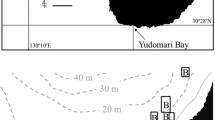Abstract
I studied the feeding behavior and diet of the carangid jack Caranx latus in a subtropical reef at Búzios Island on the southeastern Brazilian coast. Caranx latus foraged alone or in small groups of up to three individuals during daytime employing two main feeding styles: searching for prey while swimming in mid-water and following individuals of other fish species which disturbed the substrate while foraging among the rocks. The labrid wrasse Bodianus rufus was the main fish species followed by the jack. The jack feeds on crustaceans and fishes some of which are benthic rocky bottom dwellers and are caught during following. The behavioral flexibility of C. latus enables this fish to consume both crustaceans from the water column and benthic rocky dweller fishes. There is little dietary overlap between C. latus and the followed B. rufus. The interspecific feeding associations could be regarded as advantageous for C. latus allowing access to a broader range of prey categories and increasing the food intake through the consumption of large benthic fish prey
Similar content being viewed by others
References
Aronson, R.B. & S.L. Sanderson. 1987. Benefits of heterospecific foraging by the Caribbean wrasse, Halichoeres garnoti (Pisces: labridae). Env. Biol. Fish. 18: 303–308.
Baird, T.A. 1993. A new heterospecific foraging association between the puddingwife wrasse, Halichoeres radiatus, and the bar jack, Caranx ruber: evaluation of the foraging consequences. Env. Biol. Fish. 38: 393–397.
Barnes, R.D. 1987. Invertebrate zoology. Saunders College Publishing, Philadelphia. 743 pp.
Brewer, D.T., S.J.M. Blaber, D.A. Milton & J.P. Salini. 1994. Aspects of the biology of Caranx bucculentus (Teleostei: Carangidae) from the Gulf of Carpentaria, Australia. Australian J. Mar. Freshw. Res. 45: 413–428.
Carvalho-Filho, A. 1992. Peixes; costa brasileira. Marca D' Água, São Paulo. 304 pp.
Edgar, G.J. & C. Shaw. 1995. The production and trophic ecology of shallow-water fish assemblages in southern Australia. II. Diets of fishes and trophic relationships between fishes and benthos atWestern Port, Victoria. J. Exp. Mar. Biol. Ecol. 194: 83–106.
Hobson, E.S. 1974. Feeding relationships of teleostean fishes on coral reefs in Kona, Hawaii. U.S. Fish. Bull. 72: 915–1031.
Hobson, E.S. & J.R. Chess. 1986. Relationships among fishes and their prey in a nearshore sand community of southern California. Env. Biol. Fish. 17: 201–226.
Hyslop, E.J. 1980. Stomach contents analysis - a reviewof methods and their application. J. Fish Biol. 17: 411–429.
Kaestner, A. 1970. Invertebrate zoology, volume III, Crustacea. Interscience Publishers, New York. 523 pp.
Laprise, R. & S.J.M. Blaber. 1992. Predation by moses perch, Lutjanus russeli, and blue-spotted trevally, Caranx bucculentus, on juvenile brown tiger prawn, Penaeus esculentus: effects of habitat structure and time of day. J. Fish Biol. 40: 489–653.
Lehner, P.N. 1979. Handbook of ethological methods. Garland S.T.P.M., New York. 403 pp.
Lowe-McConnell, R.H. 1987. Ecological studies in tropical fish communities. Cambridge University Press, Cambridge. 382 pp.
Menezes, N.A. & J.L. Figueiredo. 1980. Manual de peixes marinhos do sudeste do Brasil, IV(3). MZUSP, São Paulo. 96 pp.
Menezes, N.A. & J.L. Figueiredo. 1985. Manual de peixes marinhos do sudeste do Brasil, V (4). MZUSP, São Paulo. 105 pp.
Potts, G.W. 1980. The predatory behaviour of Caranx melampygus (Pisces) in the channel environment of Aldabra Atoll (Indian Ocean). J. Zool. London 192: 323–350.
Randall, J.E. 1967. Food habits of reef fishes of the West Indies. Stud. Trop. Oceanogr. Miami 5: 665–847.
Sabino, J. & I. Sazima. 1999. Association between fruit-eating fish and foraging monkeys in western Brazil. Ichthyol. Explor. Freshwaters 10: 309–312.
Sackley, P.G. & L.S. Kaufman. 1996. Effect of predation on foraging height in a planktivorous coral reef fish, Chromis nitida. Copeia 1996: 726–729.
Sancho, G. 2000. Predatory behaviors of Caranx melampygus (Carangidae) feeding on spawning reef fishes: a novel ambushing strategy. Bull. Mar. Sci. 66: 487–496.
Sanderson, S.L., C.R. Chesnutt & P.S. Lobel. 1996. Evidence for ram suspension feeding by the piscivore, Seriola dumerili (Carangidae). Env. Biol. Fish. 46: 365–373.
Sazima, I. 1984. Scale-eating in characoids and other fishes. pp. 9–23. In: T.M. Zaret (ed.) Evolutionary Ecology of Neotropical Freshwater Fishes, Developments in Env. Biol. Fish. 3, Dr W. Publishers, The Hague.
Sazima, I. 1986. Similarities in feeding behaviour between some marine and freshwater fishes in two tropical communities. J. Fish Biol. 29: 53–65.
Sazima, I. 1998. Field evidence for suspension feeding in Pseudocaranx dentex, with comments on ram filtering in other jacks (Carangidae). Env. Biol. Fish. 53: 225–229.
Sikkel, P.C. & P.D. Hardison. 1992. Interspecific feeding associations between the goatfish Muloides martinicus (Mullidae) and a possible aggressive mimic, the snapper Ocyurus chrysurus (Lutjanidae). Copeia 1992: 914–917.
Sphigel, M. & L. Fishelson. 1989. Food habits and prey selection of three species of groupers from the genus Cephalopholis (Serranidae: Teleostei). Env. Biol. Fish. 24: 67–73.
Stauffer, J.R., T.J. LoVullo & H.Y. Han. 1996. Commensalistic feeding relationships of three lake Malawi fish species. Trans. Amer. Fish. Soc. 125: 224–229.
Strand, S. 1988. Following behavior: interspecific foraging associations among Gulf of California reef fishes. Copeia 1988: 351–357.
Author information
Authors and Affiliations
Rights and permissions
About this article
Cite this article
Silvano, R.A. Feeding Habits and Interspecific Feeding Associations of Caranx Latus (Carangidae) in a Subtropical Reef. Environmental Biology of Fishes 60, 465–470 (2001). https://doi.org/10.1023/A:1011064923544
Issue Date:
DOI: https://doi.org/10.1023/A:1011064923544




